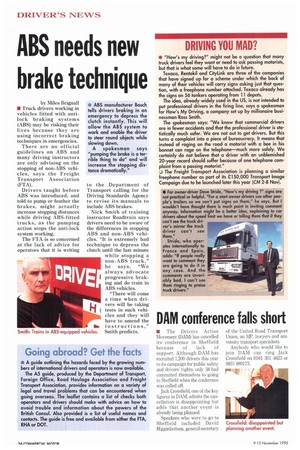ABS needs new ' brake technique
Page 26

If you've noticed an error in this article please click here to report it so we can fix it.
by Miles Brignall • Truck drivers working in vehicles fitted with antilock braking systems (ABS) may be risking their lives because they are using incorrect braking techniques in emergencies.
There are no official guidelines on ABS and many driving instructors are only advising on the stopping of non-ABS vehicles, says the Freight Transport Association (ETA).
Drivers taught before ABS was introduced, and told to pump or feather the brakes, might actually increase stopping distances while driving ABS-fitted trucks, as the pumping action stops the anti-lock system working.
The vrA is so concerned at the lack of advice for operators that it is writing to the Department of Transport calling for the Driving Standards Agency to revise its manuals to include ABS brakes.
Nick Smith of training instructor Roadtrain says drivers need to be aware of the differences in stopping ABS and non-ABS vehicles. "It is extremely bad technique to depress the clutch until the last minute while stopping a non-ABS truck," he says. "We always advocate progressive braking and do train in ABS vehicles.
"There will come a time when drivers will be taking tests in such vehicles and they will have to amend the instructions," Smith predicts. • ABS manufacturer Bosch tells drivers braking in an emergency to depress the clutch instantly. This will allow the ABS system to work and enable the driver to steer round objects while slowing down.
A spokesman says "pumping the brake is a terrible thing to do" and will increase the stopping distance dramatically."




















































































































